In the gardening class which I took last weekend, I have learned how to transplant a tree. While I have never thought that transplanting a tree is an easy task, I wouldn’t expect that it could be quite difficult either (especially on a hot summer day). And here, I would like to share some key points of tree transplanting.
Root pruning can greatly increase the chances of successful transplanting, especially for big trees. We should prune the roots 3 months – 2 years in advance. By severing the roots at or just beyond the drip line of the tree to be moved, the long unbranched roots will be broken. This will prompt growth of new roots near the main trunk, compact the existing root system, and increase the tree’s chances of survival once it is moved.
In addition, when transplanting the tree, the soil shouldn’t be too dry or too wet. If the soil is dry, water the tree 3 days in advance (we need to give our tree some time to drink the water too). On the other hand, if the soil is too wet, we can either wait for a few days till the soil gets drier, or dig a trench and drain out the excess water.
The diameter of the rootball should be 4-8 times the diameter of the tree trunk. While we dig and form the rootball, we probably have to cut through some long roots. Make a nice, clean cut with a sharp shovel or pruning shears.
And since we have cut off so many roots from the tree, we need to trim off 1/2 – 2/3 of its leaves and branches in order to reduce the amount of water evaporates and escapes from its foliage.
Set the plant and its ball of soil on a piece of burlap, wrap the burlap around the soil to keep it from crumbling. Moreover,we should get extra help when we move the tree. Even small shrubs are heavy. We don’t want to drop and crack the rootball when we are moving the tree to its new home.
It is preferred have the new hole ready before we dig up our tree or shrub. The width of the new hole should be twice that of the rootball. The depth should be 20 cm deeper.
When we reach the bottom of the new hole,do not break up the soil beneath, but keep a flat, solid surface instead. Instead of allowing the roots to penetrate deeper into the ground, breaking up the soil may cause the tree to sink, inviting rot.
Gently slide the tree into the hole, and get it straight. Take away the burlap, shovel the excavated soil back into the hole, and tamp the soil down firmly.
For trees taller than 6 feet high, they won’t initially have the strength to support themselves right being planted and will need to be staked to get off to a good start. Staking will help control the movement of the tree, while allowing its roots to grow and develop strong enough to hold the tree.
Although I often see trees get fastened with supporting stakes at 1/2, or even as low as 1/3, of its height up from the ground, my teacher suggests us to tie the supporting stakes at 2/3 of the tree’s height for strong support.
And last but not least, water, water, water! Water the tree thoroughly.
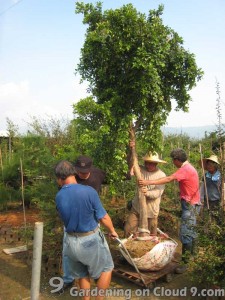
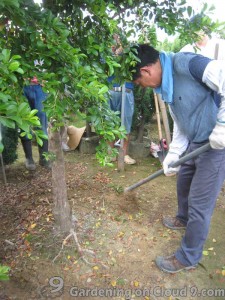
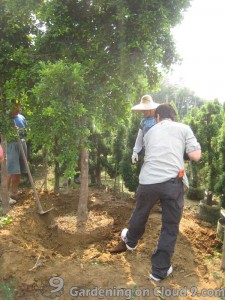
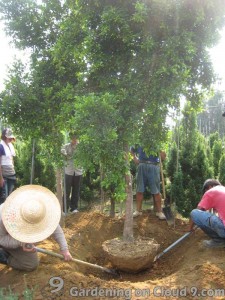
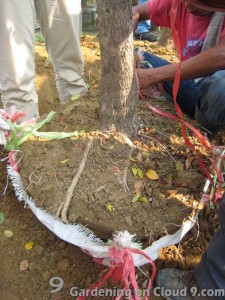
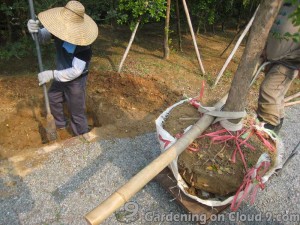
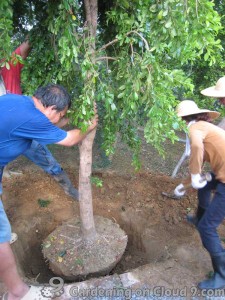
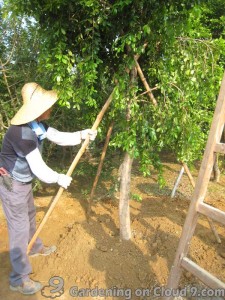
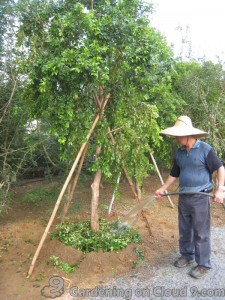



It is not easy to plant and nurture a tree. Therefore, it is sad to hear of loggers cutting off trees and leaving forests bald.
it is sad to see a place that was once covered with trees, suddenly bare. But at the same time, they don’t stay bare forever.
I’ve visited the same wild land nearly every year for about 20 years and I’ve gotten to watch the growth and harvest of trees over time. Loggers harvest, grasses, flowers, and fast-growing things spring up, trees sprout and are protected by the taller things around them. in a couple years, you can see the new trees are getting bigger and stronger.
If they cleared the whole forest, i would get worried, but they only take a couple acres at a time, so it’s still surrounded by full grown forest on all sides, therefore re-seeding doesn’t take much “effort.” That is, effort of the birds, squirrels, deer, raccoons, and other wildlife, and the wind. Actually, in that same area, there are also places where someone planted trees after that area was harvested.
super long response to a short post, but i thought i would share some hope that all is not lost if a small area is bare. even if it looks bad to us for awhile. 🙂
~Leah~
ps, Sandy, thanks for the tips on transplanting trees! I’ll be sharing it with my parents because they like letting trees grow wild, and then moving them to more ideal locations in their yard… only a few of their efforts have been successful. 😛
~Leah~
Thanks to both Autumn Belle and Leah for sharing your thoughts on cutting trees and bare forest. Like Autumn Belle, I feel sad when I see a tree get cut and removed, with nothing left but only the tree stump. And it is really interesting to hear the point of view of someone like Leah, who has kept visiting a wild land for around 20 years, seeing trees and plants come and go, old ones fall and die, while new ones sprout and grow. Very interesting! 🙂